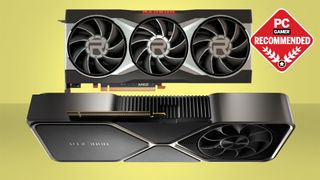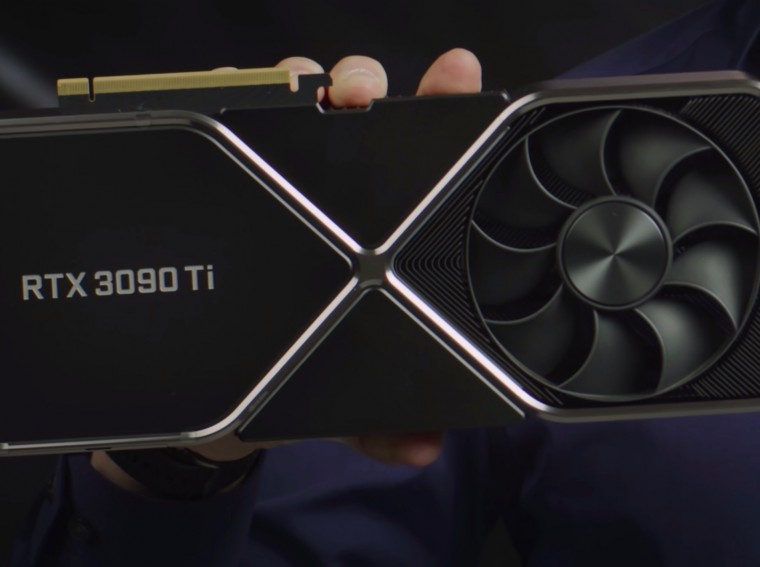Nvidia

(Image credit: AMD and Nvidia)
The best graphics card isn’t an easy thing to come by right now. Even the worst graphics card is tough to find. For that reason it’s difficult to judge price to performance of the latest releases, and an even tougher job ranking them. But we’ve put as much information below as we can on where we think these cards deserve to sit, in order to give you some idea of which card you should be searching for in store.
It will also help to know how these graphics cards fare individually when looking for the best prebuilt gaming PC, which is likely your best bet for buying a new graphics card in 2022. So let’s take a look.
As demand soars and supply wains, the best graphics cards are hard to find. Yet it’s not an impossible task—remember that. If you know exactly what sort of price/performance you’re after, you may be able to find a powerful graphics card that’s worth your money in 2022. We have plenty of tips on how to buy a graphics card if you’re unsure where to start your hunt, but scroll on to see our recommendations from Nvidia and AMD’s latest line-ups.
Although Covid-19 and cryptocurrency booms (among other things) have helped to stretch the GPU market to its limits, we’ve still managed to test every new graphics card from the most recent generation. We’ve put each GPU through our gaming benchmark test bench wringer, with in-depth analysis comparing thermal performance, power draw measurements with dedicated tools, along with average frequencies and frame times.
Finally, as we’ve noticed from our testing, the GPU market is getting competitive again. With the launch of the Radeon RX 6800 XT things got very interesting, leaving both Nvidia and AMD vying for the best GPU crown. Soon enough, Intel will drop in with its Arc Alchemist graphics card. That’s likely to make the GPU landscape a little more complicated.
Nvidia’s Ampere GPU generation has set the bar high for prospective contenders. The GeForce RTX 3080 and GeForce RTX 3070 are two of the best graphics cards to date, though the RTX 3080 12GB has made that a tough recommendation at its new high price. AMD isn’t far behind with the Radeon RX 6800 XT—it rivals even the RTX 3080’s stellar graphical performance at the high end. We’ll have to wait and see if there’s room for Intel’s contributions.
We’ve had some mid-range GPUs from both Nvidia and AMD, such as the RX 6600 XT and RTX 3060 12GB. And then there are the cheapest of the lot, the RTX 3050 and RX 6500 XT.
Best graphics card

Okay, right now, the RTX 3080 is rare as pigeon eyelashes, but there is no doubt Nvidia’s new RTX 3080 is the best graphics card today. It represents a huge generational performance boost over the previous RTX 20-series. That’s impressive when put up against either the RTX 2080 or 2080 Super, but when you consider that this nominally $699 card can not just match but massively outperform the $1,200 RTX 2080 Ti, it really hits home.
The thing which really stands out from our testing is the difference it makes to ray-tracing performance. The first generation of ray tracing-capable cards required such a huge frame rate sacrifice that most people shied away from turning it on, but that’s no longer the case with this generation.
When you can now get ray-traced performance that exceeds the frame rates you’d get out of the top card of the RTX 20-series when running without it, you know that this is a whole different beast. And hey, the RTX 3080 can actually run Crysis.
Nvidia has managed this by adding a whole load more CUDA cores to the mix in this 8nm GPU and updated Tensor Cores (for extra DLSS goodness) and second-gen RT Cores to make with the ray-traced pretties.
The RTX 3080 may need a fair chunk more power—you’ll want at least an 850W PSU—and be tricky to get hold of, but this is the most desirable graphics card around today. Which I guess is also why it’s so tricky to get hold of.
Read our full Nvidia RTX 3080 review (10GB Founders Edition).

As a red team alternative to Nvidia’s high-end graphics cards, there have been few finer than the RX 6800 XT. A highly competitive card that comes so close to its rival, with a nominal performance differential to the RTX 3080, is truly an enthusiast card worth consideration for any PC gamer with 4K in their sights.
It’s a tough call between it and the RTX 3080, but the latter pips AMD to the post with the final touches à la RTX. The RX 6800 XT is $50 cheaper, delivers high 4K performance and a hefty VRAM increase over the RTX 3080. However, it’s easy to argue that an extra $50 dropped on the RTX 3080 is money well spent: a small price to pay for greater 4K performance, much-improved ray tracing, and DLSS. All are available today and with two year’s worth of developer support in the bank. That said, AMD’s FidelityFX Super Resolution is gaining momentum among developers, and offers solid upscaling worth enabling in supported games.
Yet we’re still big fans of what AMD has managed to accomplish with the RX 6800 XT, a return to form for the Radeon Technology Group that injects some much-needed competition into the GPU market and offers a worthy red team alternative for any high-end gaming PC build.
Read our full AMD RX 6800 XT review.

The best value Ampere to date, the RTX 3060 Ti is very closely related to the RTX 3070. Both utilize the same GA104 GPU (the RTX 3060 Ti has fewer SMs enabled), with the same 8GB of GDDR6 memory across a 256-bit bus.
While 17% less capable in core count, the RTX 3060 Ti makes up for it with some judicious GPU Boost frequencies. That partially explains why the RTX 3060 Ti can be within 17% to just single digits off the pace of the RTX 3070, despite operating at a silicon disadvantage. Not bad for a $399 card (if you can find it for that price).
If you haven’t already done the maths: At $399, the RTX 3060 Ti is 20% cheaper than the RTX 3070, so performance per dollar is on the up with the diminutive graphics card. That’s why we love it so; it’s a great GPU for the full stack of resolutions and has decent ray tracing capability to boot, courtesy of second-generation RT Cores.
If the RTX 3080 or RTX 3070 seem out of reach, the RTX 3060 Ti certainly makes for a decent stand-in. Perhaps most impressive of this graphics card is how it stacks up to the 20-series generation: It topples the RTX 2080 Super in nearly every test.
Read our full Nvidia RTX 3060 Ti review (Founders Edition).

Perhaps the only high-end Ampere that’s anything close to reasonably affordable, the RTX 3070 is also impressive for its ability to match the top-string Turing graphics card, the RTX 2080 Ti, for less than half of its price tag.
At $499, it’s still a significant sum by any means—we’re talking next-gen console equivalent pricing here—but it’s hardly an exorbitant sum when compared to PC gaming’s top graphics silicon today. In return, you’re gifted a 4K-capable graphics card that doesn’t require too much fiddling to reach playable, if not high, framerates. And it’ll absolutely smash it at 1440p, no question about that.
Its gaming performance credentials are undoubtedly impressive, but what makes the RTX 3070 our pick for the sensible PC gaming connoisseur is the entire Nvidia ecosystem underlying the RTX stack today. DLSS is a neat trick for improving performance, with only a nominal loss in clarity, and other features such as Broadcast and Reflex go a long way to sweetening the deal.
Read our full Nvidia RTX 3070 review (Founders Edition).
Best CPU for gaming | Best DDR4 RAM | Best gaming motherboards
Best SSD for gaming | Best gaming laptop | Best gaming monitors

The RTX 3090 may have sat unchallenged at the top rungs of graphics performance at launch, but it wouldn’t be long until AMD rustled together a challenger in the RX 6900 XT, or ‘Big Navi.’ The RX 6900 XT hopes to knock Ampere’s finest from its perch on high and send it spiraling back down to Earth. And it gets kind of close, too, with 4K performance a little off the pace of the RTX 3090—and all for one-third off the asking price.
For that reason, it’s simply the better buy for any PC gamer without any ulterior motives of the pro-creator variety. But there’s a reason it’s not number one in our graphics card guide today, and that’s simply due to the fact it’s not that much better than an RTX 3080, and sometimes not at all. It’s another $300 on top of the RTX 3080’s price tag, and you’d hope for higher performance in both rasterized and ray tracing workloads. Yet, inevitably its ray-tracing acceleration lags behind the competition.
But the RX 6900 XT does come with assurances that the RTX 3080 can’t make, such as its 16GB of GDDR6 memory, which is a whole 6GB greater than the 10GB of (faster) GDDR6X memory on the green team card. With that in mind, for raw gaming alone, the RX 6900 XT is a cheaper alternative to the RTX 3090 is still a victim to its own extreme price tag.
Read our full AMD RX 6900 XT review.

The RTX 3080 Ti isn’t the mightiest GeForce graphics card that Nvidia makes. That accolade goes to the RTX 3090, by a hair, and will undoubtedly be claimed by the RTX 3090 Ti once that arrives. Though when all is said and benchmarked, it is the uber high-end RTX 3080 Ti that we’d recommend to any PC gamer looking to go all out on their next build.
With performance close to the RTX 3090 at 4K, the RTX 3080 Ti is as much a gaming graphics card as its progenitor. With a vast bounty of CUDA Cores and speedy GDDR6X memory, this card demolishes any game you can throw at it with relative ease. It’s also more than capable of real-time ray tracing, courtesy of 80 RT Cores.
The reason we don’t rate this card higher up in our list of the best graphics cards, however, is down to its price. Launching at $1,200, it’s only a stone’s throw away from the $1,499 RTX 3090. Massively inflated pricing, or lack of stock, notwithstanding.
Read our full Nvidia RTX 3080 Ti review (Founders Edition).

The decision to load the RTX 3060 with 12GB of GDDR6 memory appeared a strange one at first, and in many ways it still is. It’s more memory than the RTX 3080, after all, albeit slower stuff, and it tops out the RTX 3060 Ti too. However, the RTX 3060 wields it well, managing to dispatch the RTX 2060 by a large margin in most games, and by enough of a gap in the rest to make it worthwhile.

Best gaming PC: the top pre-built machines from the pros
Best gaming laptop: perfect notebooks for mobile gaming
And we’re not going to turn our noses up at 12GB of VRAM when 6GB is the likely alternative.
With a decent generation-on-generation improvement and plenty of speed at 1080p and 1440p, the RTX 3060 12GB is a graphics card easily argued for. It’s also nominally cheaper than the RTX 2060 was on launch day, though it’s not so easy to find it as a discrete number nowadays. That said, this card often crops up within pre-built gaming PCs, and for a decent price all-inclusive too.
Read our full Nvidia GeForce RTX 3060 12GB review (Zotac Twin Edge).

There is no graphics card under $300 that we would recommend bar the GeForce RTX 3050. Though it didn’t take much to defeat AMD’s Radeon RX 6500 XT. The RTX 3050 is still a difficult GPU to recommend heartily, however, as it’s neither readily available or as cheap as it should be.
The RTX 3050 is a much smaller GPU than the RTX 3060 12GB, and like any good PC gamer we would recommend the larger chip. That said, if you can’t stretch your budget any further, the RTX 3050 will deliver GTX 1660 Ti performance with the benefit of DLSS.
There’s also support for ray tracing with the RTX 3050, though its weak-heart innards aren’t going to stand for much of that.
As the basis of a prebuilt gaming PC, the RTX 3050 is the better option of what’s out there on a tight budget. That said, you can find really good RTX 3060 12GB PC deals out there fairly regularly, and with a little patience you may be able to grab a much more capable graphics card.
Read our full Nvidia GeForce RTX 3050 review (Gigabyte Eagle).
Graphics card FAQ




